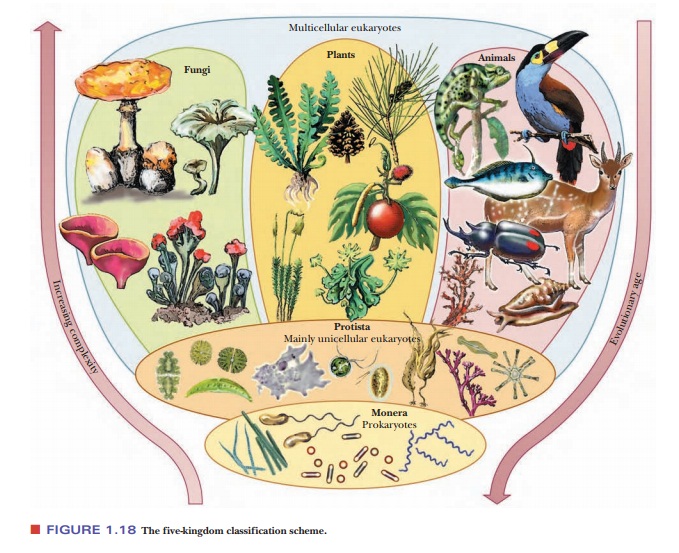Chapter: Biochemistry: Biochemistry and the Organization of Cells
Five Kingdoms, Three Domains

Five Kingdoms, Three Domains
Living
organisms can be classified in many possible ways. The original biologi-cal
classification scheme, established in the 18th century, divided all organisms
into two kingdoms: the plants and the animals. In this scheme, plants are
organisms that obtain food directly from the Sun, and animals are organisms
that move about to search for food. There are many other methods, however. For
example, one could distinguish life based on whether the organism had a cell
wall or not, or whether the organism was single-celled or not.
With the
original classification, researchers discovered that some organ-isms, bacteria
in particular, do not have an obvious relationship to either king-dom. It has
also become clear that a more fundamental division of living organ-isms is
actually not between plants and animals, but between prokaryotes and
eukaryotes. In the 20th century, classification schemes that divide living
organ-isms into more than the two traditional kingdoms have been introduced.
How do scientists classify living organisms today?
A
five-kingdom system takes into account the differences between prokaryotes and
eukaryotes, and it also provides classifications for eukaryotes that appear to
be neither plants nor animals.
The kingdom Monera consists only of prokaryotic organisms. Bacteria and cyanobacteria are members of this kingdom. The other four kingdoms are made up of eukaryotic organisms. The kingdom Protista includes unicel-lular organisms such as Euglena, Volvox, Amoeba, and Paramecium. Some protists, including algae, are multicellular. The three kingdoms that consist mainly of multicellular eukaryotes (with a few unicellular eukaryotes) are Fungi, Plantae, and Animalia. The kingdom Fungi includes yeasts, molds, and mushrooms. Fungi, plants, and animals must have evolved from simpler eukaryotic ances-tors, but the major evolutionary change was the development of eukaryotes from prokaryotes (Figure 1.18).

One
group of organisms can be classified as prokaryotes in the sense that the
organisms lack a well-defined nucleus. These organisms are called archae-bacteria (early bacteria) to
distinguish them from eubacteria (true
bacteria)because there are marked differences between the two kinds of
organisms. Archaebacteria are found in extreme environments (see the
Biochemical Connections box) and, for this reason, are also called
extremophiles. Most of the differences between archaebacteria and other
organisms are biochemical features, such as the molecular structure of the cell
walls, membranes, and some types of RNA.
Is there a simpler basis for classifying organisms?
Some
biologists prefer a three-domain classification scheme-Bacteria (eubac-teria), Archaea
(archaebacteria), and Eukarya
(eukaryotes)-to the five-kingdom classification (Figure 1.19). The basis for
this preference is the emphasis on biochemistry as the basis for
classification.

The
three-domain classification scheme will certainly become more impor-tant as
time goes on. A complete genome of the archaebacterium Methanococcusjannaschii has been obtained. More than half the genes
of this organism (56%) differ markedly from genes already known in both
prokaryotes and eukaryotes, a piece of evidence that lends strong support to a
three-domain classifica-tion scheme. Complete genomes are being obtained for
organisms from all three domains. They include those of bacteria such as Haemophilus influenzae and Escherichia coli, the latter being a
bacterium in which many biochemical pathways have been investigated. Complete
sequences for eukaryotes such as Saccharomyces
cerevisiae (brewer’s yeast),
Arabidopsis thaliana (mouse-ear cress),and Caenorhabditis elegans (a nematode) have been obtained (Figure
1.20). The sequencing of the genomes of the mouse (Mus musculus) and Drosophila
mela-nogaster (a fruit fly) has also been completed, with genome sequences
of manymore organisms on the way. The most famous of all genome-sequencing
proj-ects, that for the human genome, has received wide publicity, with the
results now available on the World Wide Web.

Summary
In the five-kingdom
classification scheme, prokaryotes have a kingdom to themselves (Monera). The
remaining four kingdoms-protists, fungi, plants, and animals-consist of
eukaryotes.
In the
three-domain classification schemes, eukaryotes have a domain to themselves.
Two domains consist of prokaryotes. Eubacteria are the commonly encountered
prokaryotes. Archaea are organisms that live in extreme environments such as
those that were found on the early Earth.
Related Topics